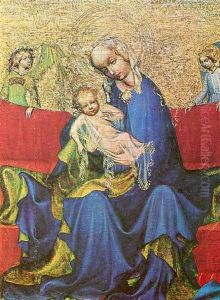Master of the Neuhaus Madonna Paintings
The Master of the Neuhaus Madonna is a designation for an anonymous Gothic painter active in the Swabian region of present-day Germany during the late 15th century, particularly around the 1480s. The name 'Master of the Neuhaus Madonna' is a notname, a conventional method of naming unidentified artists responsible for significant works of art, after a notable piece or location associated with their work. This specific moniker comes from the artist's most recognized masterpiece, the 'Neuhaus Madonna,' a painting that originally resided in the castle of Neuhaus in Paderborn, Germany. The painting is characterized by its intricate detail, vibrant color palette, and the tender representation of the Virgin Mary and Child, reflecting the stylistic tendencies of late Gothic art transitioning into the Renaissance period.
The Master of the Neuhaus Madonna's work is significant for its detailed portrayal of religious themes, common among artists of the time, yet distinguished by a unique flair for emotional expression and technical skill. His oeuvre likely includes several altarpieces, panel paintings, and possibly manuscript illuminations, although attributing specific works to him is challenging due to the anonymity and the common stylistic traits shared with contemporaries.
The identity of the Master of the Neuhaus Madonna remains a mystery, with scholars speculating that he could have been part of a larger workshop or a traveling artist, given the stylistic similarities between his work and other known artists of the Swabian region. The lack of documented records makes it difficult to trace his life or career path. Nonetheless, his surviving works continue to be studied for their contribution to the understanding of late 15th-century German art, offering insights into the period's aesthetic preferences, religious sentiments, and the transition from medieval to early modern artistic expressions.
Despite the anonymity, the Master of the Neuhaus Madonna's legacy lies in the beauty and quality of his surviving works, which have been preserved in various collections and museums, allowing a glimpse into the rich artistic landscape of late medieval Germany. His influence is seen in the continuation of certain stylistic elements by subsequent artists in the region, bridging the gap between the Gothic tradition and the emerging Renaissance sensibility.
